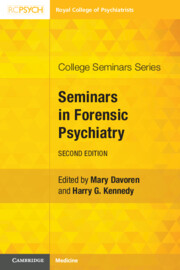Book contents
- Seminars in Forensic Psychiatry
- College Seminars Series
- Seminars in Forensic Psychiatry
- Copyright page
- Contents
- Contributors
- Foreword
- Introduction
- Chapter 1 Violence and Mental Disorder
- Chapter 2 Violence and Mental Disorder
- Chapter 3 Outcomes from the Key Inquiries and the Evolution of Modern Forensic Psychiatry
- Chapter 4 Prison Psychiatry
- Chapter 5 Legal Issues and Expertise in Forensic Psychiatry
- Chapter 6 Expertise, Structured Professional Judgement and Risk Assessment
- Chapter 7 Models of Care in Forensic Psychiatry
- Chapter 8 Psychopharmacology of Chronic Aggression and Violence in Forensic Settings
- Chapter 9 Ward Milieu and the Management of In-Patient Violence
- Chapter 10 Community Forensic Psychiatry Including Liaison with Health, Criminal Justice and Public Protection Agencies
- Chapter 11 Assessment of Personality Disorder, Psychopathy and Associated Offending Behaviour
- Chapter 12 Stalking and Threats to Harm and Kill
- Chapter 13 Sexual Offending
- Chapter 14 Terrorism-Related Assessments
- Chapter 15 Forensic Psychotherapy and Psychological Therapies in Forensic Mental Health Settings
- Chapter 16 Forensic Aspects of Medical Negligence
- Chapter 17 Child and Adolescent Forensic Mental Health Services
- Chapter 18 Women’s Services in Forensic Psychiatry
- Chapter 19 Forensic Psychiatry and Intellectual Disability
- Chapter 20 Cultural Service Delivery in Forensic Mental Health Services
- Chapter 21 Tackling Ethnic Inequality in Forensic Mental Healthcare
- Chapter 22 Academic Forensic Psychiatry
- Chapter 23 The No-Nonsense Guides
- Index
- References
Chapter 9 - Ward Milieu and the Management of In-Patient Violence
Use of Seclusion and Other Restrictive Practices
Published online by Cambridge University Press: aN Invalid Date NaN
- Seminars in Forensic Psychiatry
- College Seminars Series
- Seminars in Forensic Psychiatry
- Copyright page
- Contents
- Contributors
- Foreword
- Introduction
- Chapter 1 Violence and Mental Disorder
- Chapter 2 Violence and Mental Disorder
- Chapter 3 Outcomes from the Key Inquiries and the Evolution of Modern Forensic Psychiatry
- Chapter 4 Prison Psychiatry
- Chapter 5 Legal Issues and Expertise in Forensic Psychiatry
- Chapter 6 Expertise, Structured Professional Judgement and Risk Assessment
- Chapter 7 Models of Care in Forensic Psychiatry
- Chapter 8 Psychopharmacology of Chronic Aggression and Violence in Forensic Settings
- Chapter 9 Ward Milieu and the Management of In-Patient Violence
- Chapter 10 Community Forensic Psychiatry Including Liaison with Health, Criminal Justice and Public Protection Agencies
- Chapter 11 Assessment of Personality Disorder, Psychopathy and Associated Offending Behaviour
- Chapter 12 Stalking and Threats to Harm and Kill
- Chapter 13 Sexual Offending
- Chapter 14 Terrorism-Related Assessments
- Chapter 15 Forensic Psychotherapy and Psychological Therapies in Forensic Mental Health Settings
- Chapter 16 Forensic Aspects of Medical Negligence
- Chapter 17 Child and Adolescent Forensic Mental Health Services
- Chapter 18 Women’s Services in Forensic Psychiatry
- Chapter 19 Forensic Psychiatry and Intellectual Disability
- Chapter 20 Cultural Service Delivery in Forensic Mental Health Services
- Chapter 21 Tackling Ethnic Inequality in Forensic Mental Healthcare
- Chapter 22 Academic Forensic Psychiatry
- Chapter 23 The No-Nonsense Guides
- Index
- References
Summary
Increasingly, secure forensic mental health services must balance reducing restrictive practices on one hand with keeping a violence free environment on the other. Nursing staff and other hospital staff have the right to work in a safe environment. They should not be subject to intimidation and assaults in the work setting. Patients have the right to care in a safe environment and they need to have confidence that staff members can keep them safe during their in-patient stay. Minimising in-patient violence and minimising past violence for forensic patients is undermining an area of significant treatment need and may seriously limit the patient’s chance of a future successful discharge in the community. We posit in this chapter that active and careful management of ward milieu and dynamics, and active treatment of psychotic and other symptoms, together with proportionate use only of restrictive practice and thorough evaluation of any and all restrictive practice is the most effective way of managing a forensic in-patient setting to effectively reduce and prevent incidents of violence.
Keywords
- Type
- Chapter
- Information
- Seminars in Forensic Psychiatry , pp. 229 - 245Publisher: Cambridge University PressPrint publication year: 2024



